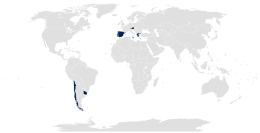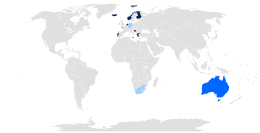| Intersex rights in Nepal | |
|---|---|
 Nepal | |
| Protection of physical integrity and bodily autonomy | No |
| Protection from discrimination | Unclear |
| Intersex topics |
|---|
 |
In 2015, Nepal introduced constitutional recognition for "gender and sexual minorities".[1] Despite this, the rights situation of intersex people in Nepal[2] is unclear. Local activists have identified human rights violations, including significant gaps in protection of rights to physical integrity and bodily autonomy, and protection from discrimination.[3] A first national meeting of intersex people look place in early 2016,Organised by First openly Intersex Rights Activist Esan Regmi in Nepal. with support from the UNDP.[4]
Terminology[edit]
Intersex people are termed as 'antarlingi' अन्तरलिङ्गी in Nepali language.[5]
History[edit]
The Blue Diamond Society, established in 2001, in Nepal politically has pursued political and social rights. On December 21, 2007, the Supreme Court ruled that a new democratic government must create laws to protect LGBTI rights and change existing laws that were tantamount to discrimination.[6][7] In September 2015, several articles mentioning the rights of gender and sexual minorities in the country's new constitution were approved by Parliament after lengthy deliberation. Amongst these:
- Article 12 states that people have the right to have citizenship identification that reflects their preferred gender.
- Article 18 covers rights to equality and states that the State will not "discriminate [against] any citizens based on origin, religion, race, caste, tribe, gender, language or ideological conviction or any other status."
- Article 18 also lists "minorities, marginalized, youth, children, senior citizens, gender and sexual minorities, handicapped persons" asdisadvantaged groups that are recognized by the constitution.
The constitution went into effect on 20 September 2015.[8] These changes mean that Nepal is likely the most progressive country in South Asia, for LGBT rights.[1] Nevertheless, numerous difficulties are reported by intersex people in Nepal, including the right to change gender assignment, the right to bodily autonomy, and the right to health.[3][9]
In February 2018, Asian intersex activists published the Statement of Intersex Asia and the Asian Intersex Forum, setting out local demands.[10]
Intersex issues in Nepal may often be thought to be third sex issues,[11] and the most well-known third-gender group in South Asia is perhaps the hijra. Serena Nanda writes that: "There is a widespread belief in India that hijras are born hermaphrodites [intersex] and are taken away by the hijra community at birth or in childhood, but I found no evidence to support this belief among the hijras I met, all of whom joined the community voluntarily, often in their teens."[12] This belief has an impact when infants are born. Warne and Raza argue that an association between intersex and hijra people is mostly unfounded but provokes parental fear about the possible future life of their child.[13]
Physical integrity and bodily autonomy[edit]

Intersex persons are not protected from violations to physical integrity and bodily autonomy. A 2016 book of personal stories by intersex people from Nepal identifies a range of bodily autonomy and health issues, including "Intersex genital mutilation as a growing practice and lack of information and access to reproductive health information or care" and "Lack of access to necessary health care for those experiencing health difficulties as a result of their intersex variation".[3]
In June 2016, the United Nations Committee on the Rights of the Child questioned the Nepalese government,[11] and identified concerns about:
(a) The lack of awareness of issues related to intersex children in Nepal and the high levels of stigma and discrimination faced by intersex children; (b) The challenges faced by intersex children to access identity documents that correspond with the sex/gender identity of their choosing; and, (c) Cases of medically unnecessary surgeries and other procedures on intersex children before they are able to provide their informed consent, which often entail irreversible consequences and can cause severe physical and psychological suffering, and the lack of redress and compensation in such cases.[14]
The Committee called for investigations of human rights violations, education of medical professionals, and access to redress.[14]
Protection from discrimination[edit]

While the 2015 constitution provides protection for sexual and gender minorities, disabled people, and minorities more generally, Esan Regmi has identified a number of issues facing intersex people in Nepal, including discrimination, and a lack of intersex-specific research and actions within Nepal's LGBTI movement. Access to marriage and inheritance rights are also concerns.[3]
Identification documents[edit]
According to local intersex activists, intersex people are not able to change name or gender marker on Nepalese birth certificates, and also have difficulties in updating academic transcripts and citizenship certificates. Intersex people are often confused as 'third gender' which creates barrier in recognition.[3]
On 26 October 2020 the intersex community of Nepal laid seven bullet demands on gender recognition as follows:-
- Ensure intersex infants' right to birth certificate, as an infant be marked as 'intersex' and later on as male, female or non-binary based on their gender identity.
- Ensure intersex people's right to change name and gender marker.
- Ensure self-determination.
- Ensure use of correct gendered terms.
- Ensure right to privacy on one's intersex status, medical records and personal gender history.
- Ensure dignity, bodily integrity & autonomy.
- Remove obligatory 'other gender' or 'third gender' marking to intersex people[15]
Rights advocacy[edit]
On February 8–9, 2016, and with the support of the UNDP and other organizations, the Blue Diamond Society hosted a first national meeting on intersex issues.[4][16] The meeting was led by Esan Regmi, with 13 participants from around Nepal.
Organizations[edit]
The first Intersex Rights organization and the only one till date of Nepal is Campaign for Change.[17]
See also[edit]
- Intersex human rights
- Blue Diamond Society
- LGBT rights in Nepal
- Hijra (South Asia)
- Human rights in Nepal
- National LGBTI Day (Nepal)
References[edit]
- ^ a b Lavers, Michael K. (September 19, 2015). "New Nepal constitution includes LGBT-specific protections". Washington Blade. Archived from the original on November 21, 2015.
- ^ United Nations Development Programme (2014). "Being LGBT in Asia: Nepal Country Report". Bangkok: United Nations Development Programme. Archived from the original on 2017-08-24.
- ^ a b c d e Regmi, Esan (2016). Stories of Intersex People from Nepal (PDF). Kathmandu. Archived (PDF) from the original on 2017-04-22.
{{cite book}}: CS1 maint: location missing publisher (link) - ^ a b Being LGBTI in Asia (February 29, 2016). "The dawn of a national intersex movement: The first national intersex workshop in Nepal". Medium. Archived from the original on August 22, 2016. Retrieved 2016-07-30.
- ^ Group, Queer Youth; Change, Campaign for (21 February 2021). Sexual Orientation, Gender Identity and Sex Characteristics (SOGIESC) : Basic concepts (PDF) (First ed.). pp. 13, 14. ISBN 978-9937-0-8469-7. Retrieved 21 November 2021.
- ^ 365gay.com, "Nepal High Court Issues Landmark Gay Ruling," 21 December 2007 Archived 22 December 2007 at the Wayback Machine
- ^ Nepal court rules on gay rights Archived 2011-08-05 at the Wayback Machine BBC News, 21 December 2007
- ^ "Nepal approves new constitution". BBC News. 17 September 2015. Archived from the original on 4 August 2016. Retrieved 13 October 2016.
- ^ Regmi, Esan (October 2016). "Growing up in Nepal". Intersex Day. Archived from the original on 2017-01-03. Retrieved 2017-05-21.
- ^ Intersex Asia (February 2018). "Statement of Intersex Asia and Asian intersex forum". Retrieved 2018-09-05.
- ^ a b "TRANSCRIPTION > Nepal Questioned over Intersex Genital Mutilations by UN Committee on the Rights of the Child - Gov Denies + Deflects". Zwischengeschlecht. May 20, 2016. Archived from the original on June 24, 2017.
- ^ Nanda, Serena. Neither Man Nor Woman: The hijras of India, p. xx. Canada: Wadworth Publishing Company, 1999
- ^ Warne, Garry L.; Raza, Jamal (September 2008). "Disorders of sex development (DSDs), their presentation and management in different cultures". Reviews in Endocrine and Metabolic Disorders. 9 (3): 227–236. CiteSeerX 10.1.1.469.9016. doi:10.1007/s11154-008-9084-2. ISSN 1389-9155. PMID 18633712. S2CID 8897416.
- ^ a b United Nations; Committee on the Rights of Child (June 3, 2016). "Concluding observations on the third to fifth periodic reports of Nepal". Geneva. Archived from the original on July 29, 2017.
- ^ "National Intersex Demand Sheet". 4 November 2020. Retrieved 21 November 2021.
- ^ UNDP in Asia and the Pacific (July 30, 2016). "Being LGBTI in Asia". Archived from the original on August 15, 2016. Retrieved 2016-07-30.
- ^ Kapali, Rukshana; Bhandari, Elyn; Mulmi, Subin (31 October 2021). Draft bill regarding gender identity, 2021 (Nepali) (PDF). Asia Pacific Transgender Network. p. 6. ISBN 978-9937-0-9592-1. Archived from the original (PDF) on 31 October 2021. Retrieved 21 November 2021.
Bibliography[edit]
- Regmi, Esan (2016). Stories of Intersex People from Nepal (PDF). Kathmandu.
{{cite book}}: CS1 maint: location missing publisher (link) - Asia Pacific Forum of National Human Rights Institutions (June 2016). Promoting and Protecting Human Rights in relation to Sexual Orientation, Gender Identity and Sex Characteristics. ISBN 978-0-9942513-7-4.